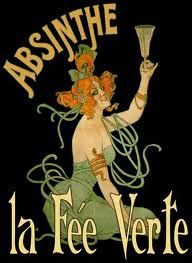Absinthe the agony and the ecstasy.
Absinthe is nothing more than an alcoholic drink that is all
but if you look at the history of this drink then you realise just what a
special drink it is. It is said that it can send you mad, a hallucinogenic and
had the dubious honour of being banned in a number of countries and still is in
some. But not in Briton as it never really caught on. So why did this drink get the reputation that
it has and why.
The temperance movement who was against anything alcoholic
along with a number of professional body’s and associations publicly stated
that, absinthe was associated with violent crimes and social disorder. It was said that “Absinthe makes you crazy and
criminal, provokes epilepsy and tuberculosis, and has killed thousands of
French people. It makes a ferocious beast of man, a martyr of woman, and a
degenerate of the infant, it disorganizes and ruins the family and menaces the
future of the country.”
In 1905 a Swiss farmer called Jean Lanfray murdered his
family and attempted to take his own life after drinking absinthe. After that
it was only a matter of time as the drink became a hotly debated and a petition
to ban absinthe collected 82000 signatures. A referendum was held and after it was passed
by a majority the prohibition was written into the Swiss constitution. The fact
that Jean Lanfray was an alcoholic and had been drinking wine and brandy before
the absinthe was over looked. This was
followed by Belgium and Brazil in 1906, the Netherlands in 1909, Switzerland in
1910,the United States in 1912 and France in 1914. But none of them where the
first as Congo Free State had band it in 1898.
In art and literature it was portrayed as a destructive potent
drink as in Edgar Degas painting L'Absinthe and Émile Zola novel L'Assommoir. The
most famous stories regarding absinthe
is that Vincent Van Gogh cut off his own
ear after drinking too much absinthe. Although it might have been a
contributing factor I think his actual metal state, and some think now the fumes
rom the paint that he was using all the time had more to do with it.
In fact it was its prohibition in so many country’s that its
production was forced underground and here it was made with cheaper and less reliable
ingredients. Cheap illegal versions had chemicals added to them, and with some
being poisonous may have made them hallucinations.
This is of course without little wonder as you look at the
spirit with its green glow or the “The green Fairy” as it is sometimes called. Its
taste neat is very strong almost unpalatable as it is a cross between cough
medicine, liquorice and anise.
Even drinking it has some kind of magical quality to it. You
are supposed to pour a measure of absinthe into a glass. Balance a silver
slotted spoon over the glass. Then place a sugar cube on top of the spoon and
chilled water would slowly be poured over it until it dissolved. The drink turning from clear to bright green as
soon as the water hits it, only stopping when you have the desired sweetness
and dilution.
Of course now absinthe is safe if drought from a reputable supplier,
and like all alcohol you take it in safe moderate quantities. In fact it is
produced in many countries now under strict
guidelines. It is made from fennel,
wormwood, and anise and a number of other ingredients but they might change
from place to place as it has no legal definition of it. You do not even have
to have a green one as now you can have the red or clear varieties.
But a final word of warning it is around 40-70% ABV and only
a little creates a sense of drunkenness. However, it is said that effects of
the herbs that absinthe contains it gives you a heightened sense of clarity. Personally
I have never liked the strong aniseed flavour to it so I do not know. Mind you if it does this could explain why so
many bohemians, writers and artists in the past use it for inspiration.




Comments
Post a Comment